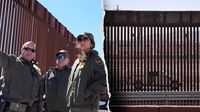On a hot Tuesday in Santa Teresa, New Mexico, U.S. Homeland Security Secretary Kristi Noem stood before a towering stretch of the U.S.-Mexico border wall, paint roller in hand, and made a striking announcement: the entire southern border barrier—spanning roughly 700 miles—will soon be coated black. This bold move, Noem explained, is more than just a cosmetic update. It’s a strategic decision, ordered directly by President Trump, aimed at making the wall too hot to climb under the relentless border sun—a new deterrent in the ongoing battle against illegal crossings.
“That is specifically at the request of the president, who understands that in the hot temperatures down here, when something is painted black it gets even warmer and it will make it even harder for people to climb,” Noem told reporters, as quoted by KFOX14/CBS4. “So we are going to be painting the entire southern border wall black to make sure that we encourage individuals to not come into our country illegally, to not break our federal laws, but that they will abide and come to our country the right way so that they can stay and have the opportunity to become United States citizens and pursue the American dream.”
This initiative is just the latest chapter in a years-long effort to secure the U.S. southern border. The wall itself, already imposing in height and extending deep underground, has been described by Noem as “very, very difficult to climb, almost impossible,” and equally challenging to tunnel beneath. The new black paint, officials say, will only amplify these deterrent effects. According to Bloomberg, the idea is simple science: black absorbs more heat. In the desert heat of the borderlands, that extra warmth could make the steel surface blisteringly hot to the touch, discouraging would-be climbers.
The paint job isn’t just about keeping people out, though. U.S. Border Patrol Chief Mike Banks, who joined Noem at the press conference, pointed out a practical benefit: “The paint would also help deter rust.” With the wall’s steel structure exposed to the elements, a coat of black paint could help preserve the barrier for years to come.
The project is massive in both scale and cost. As detailed by ABC News and other outlets, Congress recently passed the so-called “big, beautiful bill,” allocating $165 billion to the Department of Homeland Security. Of that, $46.5 billion is earmarked specifically for border wall construction, with the goal of finishing an additional 700 miles of barrier along the 2,000-mile U.S.-Mexico border. The funding also covers technology upgrades, including the installation of new cameras, sensors, and other surveillance tools to further bolster security. “With the OBBB we will be able to finish the border wall system started under President Trump’s first term,” a DHS spokesperson told Bloomberg.
During his first term, President Trump was known for his hands-on approach to the wall’s design. Reports from The Hill and other sources recall that he favored prototypes with “flat black” bollards to absorb heat and even suggested sharp spikes at the top to make the structure more intimidating. The current black paint directive is very much in line with that vision—both practical and symbolic.
But the wall is only part of a broader strategy. Secretary Noem highlighted that additional technology, such as cameras and sensors, will soon be deployed along the border. These tools, she said, are designed to make illegal crossings even less appealing and to help Border Patrol agents detect and respond to breaches more quickly. In some areas, new water-borne infrastructure is being developed, especially along the Rio Grande River in Texas, where the border is defined by water rather than land.
Noem’s visit to New Mexico wasn’t limited to the wall. She also stopped in Ruidoso to assess flood damage from severe July storms—a reminder that the region faces challenges beyond immigration. Nevertheless, the focus of her remarks remained squarely on border security. “Remember that a nation without borders is no nation at all,” she said, echoing a sentiment that has become a rallying cry for immigration hardliners. “And we’re so thankful that we have a president who understands that and understands that a secure border is important to our country’s future.”
The Trump administration’s approach to border security has evolved over time. While his first term centered on building the wall, his second has shifted toward mass deportations and increased arrests within the country’s interior. Still, the wall remains a potent symbol—and a practical barrier—of his immigration policy. According to CBC, construction crews are currently building hundreds of meters of new wall daily, with the pace dictated by local topography and geography. “The border wall will look very different based on the topography and the geography of where it is built,” Noem noted.
In addition to the physical barrier and technological enhancements, the administration has deployed thousands of military personnel to the border and taken control of narrow strips of public land. Crossing into these areas is now considered entering a military base, allowing for the detention of migrants by both Border Patrol and Defense Department personnel, as reported by CBS News.
There’s also a notable shift in migration patterns. According to multiple sources, including CBS News, illegal border crossings have plummeted to a decades-long low. In June 2025, just over 6,000 migrants were apprehended along the southern border—a steep drop from the Biden administration era, when border arrests sometimes topped 6,000 per day. The administration credits its aggressive border policies and the deterrent effect of the wall and new security measures for this decline.
The cost of painting the entire wall black remains unclear, with DHS officials declining to release specific figures, citing an ongoing procurement process. “It would be irresponsible to the American taxpayer to release the numbers as it may impact future bids,” a spokesperson told Bloomberg. Still, the overall funding for the wall and related security measures is among the largest federal investments in border infrastructure in U.S. history.
The wall’s design and construction also vary considerably along its length. In some areas, it’s a steel bollard fence; in others, it’s a solid barrier or water-borne infrastructure adapted to the unique geography of the Rio Grande. Each section is tailored to the challenges of the local landscape, with the overarching goal of making unauthorized entry as difficult as possible.
As the sun sets over the New Mexico desert, the freshly painted black wall stands as a testament to the Trump administration’s unwavering commitment to border security. Whether the new paint will truly make the wall “almost impossible” to climb, as Noem claims, remains to be seen. But one thing is certain: the border, and the debate that surrounds it, is hotter than ever—both figuratively and literally.





